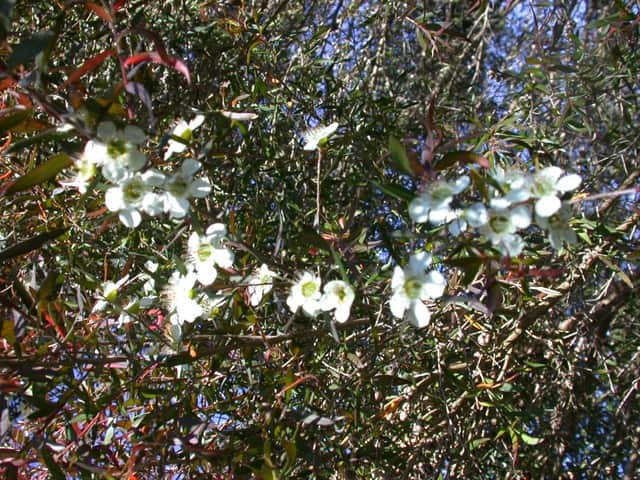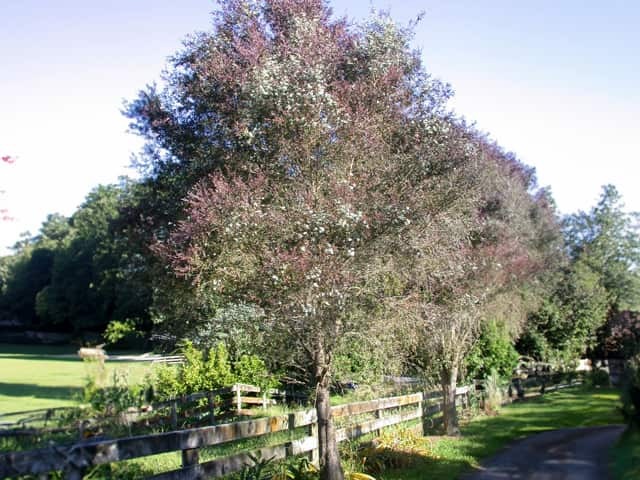Main menu
Common skin conditions

NEWS
Join DermNet PRO
Read more
Quick links
Manuka — extra information
Common name: |
Tea-tree. Note, there are 3 different species of Myrtaceae growing in Australia and New Zealand known as ‘Tea-tree’: the Australian Tea tree (Melaleuca alternifolia), the New Zealand Manuka (Leptospermum scoparium) and Kanuka (Kunzea ericoides). |
|
Botanical name: |
Leptospermum scoparium |
|
Family: |
Myrtaceae |
|
Origin: |
New Zealand and Australia, but new cultivars being developed in USA and United Kingdom. |
|
Description: |
A medium sized evergreen shrub which can grow up to 5 meters tall and 3 meters wide. Leaves are variable in shape and size; they may be elliptical, broadly lanceolate essential oils or obovate and from 7 to 20 mm long. White flowers, occasionally tinged with pink and rarely red, 1 cm in diameter, occur in spring and early summer. Many different highly ornamental cultivars are now available. The bark is stringy and peels in long flakes. |
|


Uses: |
Mostly grown as an ornamental plant. Manuka is a nursery tree and often forms large areas that protect regenerating forest seedlings and form a shelter for native orchids and other small plants. Manuka wood is red coloured, hard and durable. It has been used for fencing, for tool handles and as a firewood. Manuka was used traditionally by Māori for a variety of ailments from urinary complaints, head colds, sedation to skin disorders. Infusions and poultices were made from the leaves and inner bark and the seed capsules and sap were chewed. Early european migrants produced a tea from Manuka leaves (hence it's name). Today's modern uses are focused on topical applications for skin, cosmetic, fungal conditions and topical anti-histamine use. However, the variability in Manuka essential oils suggests caution in their usage, as does the fact that the oils have not been tested for toxicity. Manuka honey can be eaten, used in cooking or used externally. |
|
Allergens: |
Manuka essential oils include sesquiterpene hydrocarbons (> 60%), oxygenated sesquiterpenes/triketones (approx 30%), and monoterpenes ( 3%). Individual components include: monoterpene hydrocarbons, a-cubebene, b-pinene, r-cymene, g-terpinene, a-copaene, b-caryophyllene, aromadendrene, calamanene, limonene, myrcene, 8-cineole, linalool esters, copaene, elemene, gurjunene/aromadendrene, farnesene/ caryophyllene, selinene, and cadinene skeletons. |
|
Allergy: |
Allergic contact dermatitis has been reported to essential oils used in aromatherapy, from soaps/cosmetics and oils used therapeutically. |
|
Cross reactions: |
? Melaleuca alternifolia |
|
Patch test: |
Essential oils, plant and leaves |
|
References
- Lis-Balchin M, Hart SL, Deans SG. Pharmacological and antimicrobial studies on different tea-tree oils (Melaleuca alternifolia, Leptospermum scoparium or Manuka and Kunzea ericoides or Kanuka), originating in Australia and New Zealand. Phytother Res. 2000 Dec;14(8):623-9.
- Porter NG, Wilkins AL. Chemical, physical and antimicrobial properties of essential oils of Leptospermum scoparium and Kunzea ericoides. Phytochemistry. 1999 Feb;50(3):407-15.
- Allen KL, Molan PC, Reid GM. A survey of the antibacterial activity of some New Zealand honeys. J Pharm Pharmacol. 1991 Dec;43(12):817-22.
On DermNet
